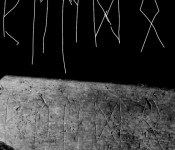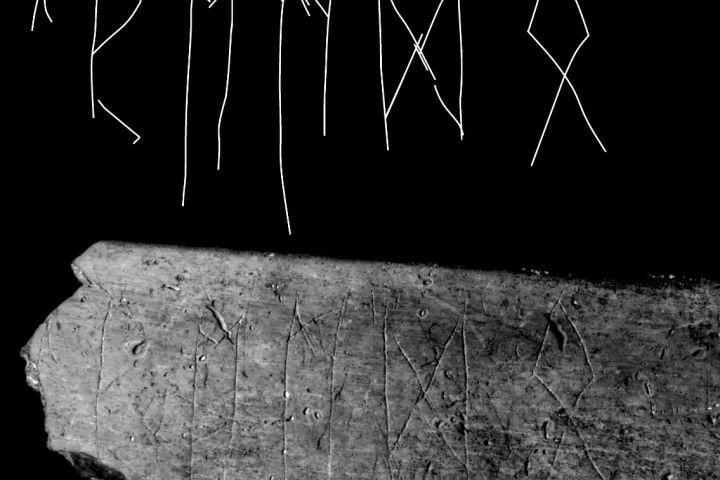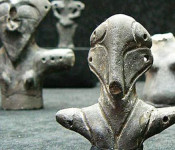Learning from a Scientific Paper, March 2021, Runes from Lány (Czech Republic) - The oldest inscription among Slavs. An Ancient Debate #archeology #Slavic Since the 19th century, Slavonic scholars had theorized that Slavs had achieved literacy pre-Christ
Monday 08 November 2021 at 2:38 pm
Runes as the oldest inscription among Slavs
Neolithic European wisdom, symbols and divine learning from a Scientific Paper, March 2021, Runes from Lány (Czech Republic) - The oldest inscription among Slavs
An Ancient Debate #Archeology #Slavic #History. Since the 19th century, Slavonic scholars had theorized that Slavs had achieved literacy pre-Christ.
Like many extraordinary discoveries, it happened by accident, just recently, and it sparked a number of years of careful scientific research.
A Czech archaeologist, Alena Slamova, was routinely cleaning the excavations from a dig when her sharp eye noticed unusual scratching on the surface of one fragment. So she has decided to examine it further with her colleagues, not dispose of it.
"Our find is the first one after nearly 200 years of discussions to suggest that it is possible that the [early Slavs] had some script," says Jiri Machacek, head of the Department of Archaeology in Brno, the co-author of the report.
The rune bone was found near the town of Breclav in what is now the Czech Republic
Alena Slamova and Jiri Machacek with the fragment of cow rib that could change a lot of what we know about the early Slavs
Runes are an alphabetic script, called fuþark, used among Germanic tribes
What scientists are after are abecedaries (passed through Europe as a script). Longer time period, more difficult the find. I.e. many inscriptions exist in younger fuþark, and there are only about 430 in older fuþark, used until 700 AC, of which only 17 contain complete, or incomplete abecedaries. Less than 100 span from 300 AC to 700 AC creating what is known as the South-Germanic corpus.
A researcher can easily imagine that the most scripts found would belong to our wealthy and influential men's graves (in Balkan read: Germanic or Ottoman or Byzantine).
During the last 2,000 years, the only women buried were Queens or Saints, surely not slaves. In Balkans, since Slavs were slaves, changing the names to reflect the power-God-Goddess structure (for example Dio-nisus. or Herodotus, or St Whoever Christian Name) was common.
What has survived came from the scripts found on metal objects in 600 AC graves containing personal names. It is a typical example of an Early Slavic settlement of the 6-700 AC. The same ones you find following the river Danube. The above mentioned rib bone fragment, originates from Břeclav Lány in South Moravia, Czechia.
Codex Runicus, 1300 AC containing one of the oldest and best preserved texts of the Scanian law (Skånske lov), written entirely in runes.
“This important find renders six of the last eight runes of the older fuþark, making it the first find containing the final part of the older fuþark in South-Germanic inscriptions, and the only one found in a non-Germanic context.”
The first written reports about Slavs, referred to Slavs as Sclavini, and their attacks on the Byzantine & later Ottoman Empire during the 600 AC – 1,500 AC. Early written mentions of Slavs include Sclauos in the 777AC, 805 AC, 822 AC, 855AC, etc.
This rune-inscribed fragment of a bone could be the first archaeological evidence for a direct contact between Germanic and Early Slavic tribes in Europe from the late 600 BC found in any Slavic settlement said the groundbreaking report.
As often happens with important archaeological discoveries, the Lany bone may shed light on old historical mysteries but also raises new questions that could open up enticing avenues of research.
One interesting puzzle facing scholars is to figure out why a Germanic script ended up being used in a Slavic setting. There is a possibility that it was written by Slavs who learned it from a Germanic tribe, or the Germanic people have learned it from the Slavs.
It is a tantalizing question that might not be solved for unfortunately, the Lany bone is the only physical evidence to date of writing among early Slavs.
"Nobody was interested in looking for inscriptions on these bones because we had no idea that something like this could be here,” says Machacek. "So perhaps now that we have this first find, we and other archaeologist colleagues will attempt to look for more… There are thousands of animal bones, and this writing could also be on some of these."
The deeply engraved runic inscriptions are no doubt authentic, they have been confirmed using optical & electron microscopy.
Yet, the conventional scientist, Robert Nedoma, an expert in comparative literature at the University of Vienna, has categorically identified it as “Elder Futhark”, the oldest known form of runic lettering used by Germanic speaking inhabitants of Central Europe.
This “categorical identification” cannot come from a Slavic Phd holder from a Balkan country because our cultural upbringing of Slaves to Germanic or Ottoman powers, during the past 2,000 years, has given us, Slavs, only a very strong “doubt as the scientific principal”.
I often wonder does this “scientific certainty” ignite this age-long nationalism.
This ancient system consisted of 24 letters.
The Serbian Vinča’s (A Danube settlement spanning 6,000 years in Neolithic Europe’s Serbia) sculptures, artifacts have used symbols for religious purposes, and these were always placed in a particular manner around the head of the sculpture.
The Egyptian script had used symbols for magical purposes.
Slavs with their maternal culture mainly used cremation graves, a few burned bones and pots. The inscription would have been on wood and burnt. Machacek suggests that the discovery of the Lany bone could eventually resonate far beyond the halls of academia.
"This period at the very beginning of the Middle Ages is a very important era," he says. "It is the period of the establishment of these nations and states in Europe that exist until now. They are our roots, and therefore, it is a very sensitive period."
"This mystery of runes was really abused in the late history, in Germany by Nazis and so on," he says. "It is a very sad history, but now we can perhaps show that this script and these runes could have been more common among various groups and various nations. And they are perhaps not only connected with Germanic mythology and Germanic history but could be part of the common heritage of Central European people generally."
Machacek says his team has received funds from the Czech Science Foundation (GACR) to continue excavating at Lany."
Read more
within World’s Black Archeological Market
Monday 18 October 2021 at 11:37 am
#goddess of old Europe #art and World’s Black Archeological Market
Neolithic European wisdom, symbols and divine learning from
Marija GIMBUTAS Earth Fertility of old Europe
Ever since its first discovery in 1908 by the Serbian archaeologist Miloje Vasić, Vinča culture, a Neolithic settlement that spanned most of Serbia, parts of Romania, Bulgaria & Macedonia, has been of great interest to the lay public and scientists alike.
Middle Bronze Age Goddess 1800 BC
From Neolithic monuments to Roman Villas and prehistoric figurines the river basin of Danube (Serbia, Romania, Bulgaria) has proved rich for treasure hunters over the years
In 2005, Police in central Germany found the artifacts that date to the Neolithic period and are believed to belong to the Vinca, in a sports bag belonging to two Serbs. Last year, a 2,000 year old Roman monument weighing half a ton was stolen in 24 hours after the find. Such epigraphic monuments, stone monuments with Latin engraving text) are extremely rare in the world so the value is extremely high.
With 100s of objects discovered, Serbia would ranke among the first in Europe for finds declared if there is not a huge Archeological Black Market that leads these priceless artifacts into foreign private hands. If you're into stats, there’s every chance with every new dig unearth more hugely significant finds. The found and stolen monument on the territory of Serbia is unique in the world because they are highly preserved with Latin (Greek) inscription in 15 lines. Based on the inscription on the monument, an expert from the National Museum found that the monument belonged to a chivalrous man. He commanded various military departments and took part in the war with the Dacians and Parthians. The special value of this monument for Serbia and Belgrade was in the fact that it was found in its original place: the ancient Singidunum.
Now Information about the monument is included in the Interpol database of stolen archaeological items so that thieves can never sell it to a museum but still it goes to someelse’s hands.
Read more
Learning from ancient art about aXuM
Friday 15 October 2021 at 1:26 pm
The Obelisk of Axum (ሓወልቲ ኣኽሱም) and divine Ark of the Covenant
The Obelisk of Axum (ሓወልቲ ኣኽሱም) is a 400 AC, 24 metre obelisk, weighing 160 tonnes, now in the city of Axum in Ethiopia. The obelisk or Hawelt in Ge'ez in Axum was a "marker" for underground burial chambers. The largest were for royal burial chambers. In Ethiopia there are only a few large ones, and hundreds of smaller ones in various "stelae fields". Near the top of the stele a small house like object is carved in relief, claimed by Ethiopians to house the original Ark of the Covenant.
Salt and Havell (1809) The Obelisk at Axum
In the 19th century, of the three major "royal" stelae, only this one, King Ezana's Stele remained erect, visible in the print "The Obelis of Axum" of Henry Salt (1780–1827).
Salt and Havell (1809) The Obelisk at Axum, Twenty-Four Views in St. Helena, The Cape, India, Ceylon, The Red Sea, Abyssinia and Egypt, London: William Miller. 1809
The Axum obelisk is regarded as one of Ethiopia's national religious treasures.
The stele was one of fifty obelisks in Axum at the time of the discovery, in 1937. Italian troops took it to Rome, Italy, cut into five pieces and transported by trucks.
“A crowd of Ethiopian ministers, priests and other VIPs cheered and clapped as it landed.” News reported the return of the obelisk. 24m tall, it weighs 160 tons, this 1,700 years old monument was welcomed by chanting priests.
Many Ethiopians see the obelisk as a vital national symbol. It was dismantled by Italian experts in 2004 in readiness for its journey home. The journey costed Italian government 6m euros. The 160-ton monument had to be broken into three pieces.
Axum was the largest, heaviest object ever transported by air. Heaters were installed and the obelisk was wrapped in steel bars for the six-hour flight. The airstrip at Axum had to be upgraded to handle the weight of the aircraft, and radar was installed.
Read more
Learning from Van Gogh & Hokusai about 19th Century Art Great Wave
Thursday 30 September 2021 at 9:19 pm
19th Century art & Search for Indefinite, Infinite Impression consciousness
Presence or Absence of divine Learning from Van Gogh & Hokusai by Nataša Pantović
The late 1800s was the time of Impressionism as a radical art movement , centered around Parisian painters, the wave that rebelled against classical subject and gave respect to Mother Nature.
Travelling to their thought-form, Vincent van Gogh to the artist friend Emile:
“But now look, ... you surely can't seriously imagine a confinement like that, in the middle of the road, with the mother starting to pray instead of suckling her child? Those bloated frogs of priests on their knees as though they're having an epileptic fit are also part of it, God alone knows how and why!
No, I can't call that sound, for if I am at all capable of spiritual ecstasy, then I feel exalted in the face of truth, of what is possible, which means I bow down before the study - one that had enough power in it to make a Millet tremble - of peasants carrying a calf born in the fields back home to the farm.
That, my friend, is what people everywhere, from France to America, have felt. And having performed a feat like that, can you really contemplate reverting to medieval tapestries? Can that really be what you mean to do? No! You can do better than that, and know that you must look for what is possible, logical and true.”
Letter from Vincent van Gogh to Emile Bernard, Saint-Rémy, 1889
“Now to enlighten you, my dear M. Van Gogh, ... I am searching for and at the same time expressing a general state of mind rather than a unique thought, to have someone else's eye experience an indefinite, infinite impression. To suggest a suffering does not indicate what kind of suffering: purity in general and not what kind of purity. Literature is one (painting also). Consequently, suggested and not explained thought.”
Letter from Paul Gauguin to Theo van Gogh. At this time, Vincent was 36 year old.
The two striking waves in Blue: 2 Great Waves - Hokusai 1883 & Van Gogh 1989
First seen outside Japan in the 1880s, Van Gogh's brother was one of the first Europeans to collect Japanese prints and has admired Japanese art.
The Starry Night Vincent Van Gogh, 1889 & Japanese print Hokusai Great Wave 1833
Read more
Learnings from Plato's Republic
Wednesday 25 August 2021 at 7:35 pm
History repeats itself and Plato about Arts
History repeats itself. And people forget about history. There is no easy fix. It is easy to think that wars are in the past, that society has changed and it will never happen again. As memory fades, Gaia’s events from the past can become events of the present. The more things change, the more they stay the same. What we are seeing is that ‘digital’ acts as a magnifier, and accelerator. The problem is still the same. The isolation of East and West, North and South. Wealth inequality is a social and civic conversations that is not new but that has been catalysed through digital media.
Manuscript from the 300 AC, containing fragments of Plato's Republic.
Plato in the Republic rejects any form of illusionism in art. He calls it mimesis or ‘imitation’. This has also created a question what is the Greek word “mimesis”? And why does this matter?
What we have not full knowledge of, we cannot reproduce. Presumably this is the reason why all the monotheistic religions (Protestant Christianity, Islam, Judaism) had an explicit problem with art and artists trying to imitate the knowledge of god, its image, his son, soul, Universe, etc. The imitation occurs in many instances, when an artist uses a portrait of a dead person to recreate his-own interpretation of the person. But Plato goes beyond it.
Read more






